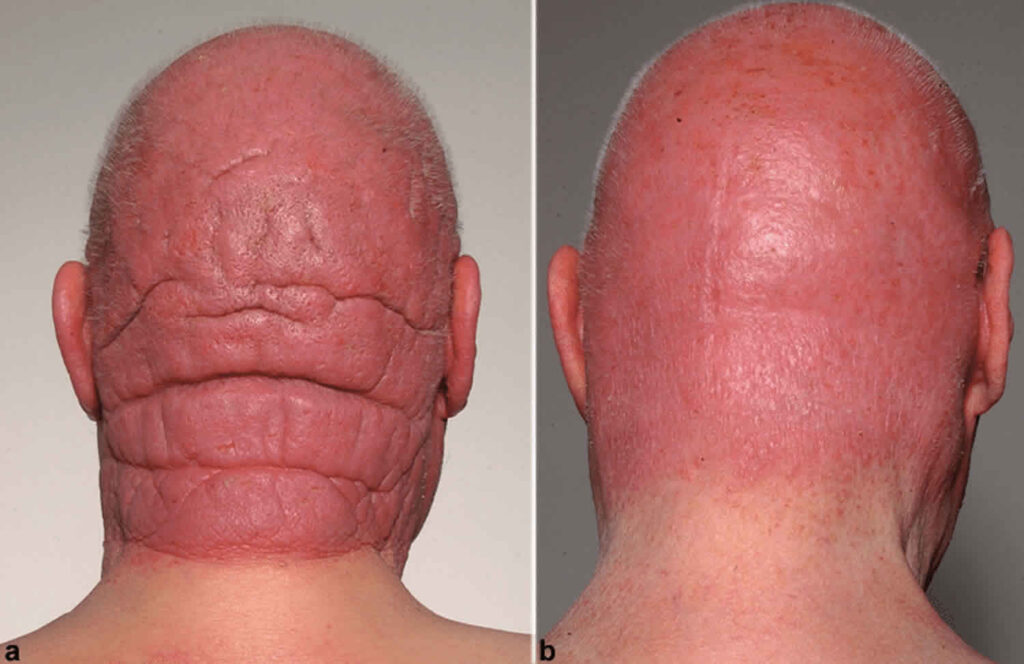Cutaneous T-cell lymphoma (CTCL) is a rare and complex form of non-Hodgkin lymphoma that primarily affects the skin. It originates from malignant T-lymphocytes, a subset of white blood cells responsible for immune response. Unlike other lymphomas, CTCL manifests as persistent skin lesions, which can progress over time and, in advanced cases, involve the blood, lymph nodes, and internal organs.

Types of Cutaneous T-Cell Lymphoma
Mycosis Fungoides
Mycosis fungoides is the most common form of CTCL, characterized by slow progression through three distinct stages:
- Patch Stage: Flat, red, scaly patches resembling eczema or psoriasis.
- Plaque Stage: Thickened, raised lesions that may be itchy or discolored.
- Tumor Stage: Large nodules or tumors that may ulcerate, increasing the risk of infection.
Lesions often develop in areas not commonly exposed to sunlight, such as the buttocks, thighs, or lower back.
Sézary Syndrome
Sézary syndrome is a more aggressive form of CTCL that affects both the skin and bloodstream. It is defined by:
- Erythroderma: Widespread redness and scaling of the skin.
- Leukemia Component: Malignant T-cells (Sézary cells) detected in the blood.
- Lymph Node Enlargement: Swollen lymph nodes due to disease progression.
Patients may also experience severe itching, hair loss, thickened palms and soles, and immune system dysfunction.
Symptoms and Clinical Presentation
CTCL presents with a wide range of skin-related symptoms, including:
- Persistent Patches and Plaques: Flat, scaly, or thickened areas on the skin.
- Skin Discoloration: Lesions may appear red, purple, or darker than the surrounding skin.
- Severe Itching: Common in both early and advanced stages.
- Ulceration and Infections: In later stages, lesions may break open, increasing the risk of secondary infections.
Because these symptoms can mimic other dermatological conditions, early diagnosis can be challenging.
Causes and Risk Factors
The exact cause of CTCL remains unknown, but several risk factors have been identified:
- Age: More common in individuals over 50 years old.
- Gender: Higher prevalence in males.
- Ethnicity: Increased incidence among Black individuals.
- Immune Dysfunction: A weakened immune system may contribute to disease development.
Environmental exposures and genetic mutations are also being studied as potential contributing factors.
Diagnosis
CTCL is diagnosed through a combination of clinical assessment and laboratory tests:
- Skin Biopsy: Affected skin samples are examined under a microscope to detect malignant T-cells.
- Blood Tests: Identifies the presence of Sézary cells and evaluates immune function.
- Imaging Studies: CT scans, PET scans, or MRI to assess disease spread.
Because CTCL can resemble other skin disorders, multiple biopsies may be required for confirmation.
Staging
CTCL is staged based on the extent of skin involvement, lymph node status, and the presence of malignant cells in the blood or internal organs:
- Stage I: Limited patches or plaques affecting less than 10% of the skin.
- Stage II: Patches or plaques covering more than 10% of the skin, with or without enlarged lymph nodes.
- Stage III: Generalized erythroderma, with or without lymph node involvement.
- Stage IV: Cancerous cells detected in lymph nodes or other organs.
Accurate staging helps determine the most effective treatment strategy.
Treatment Options
Treatment for CTCL varies based on disease stage and severity:
Topical Therapies
- Corticosteroids: Reduce inflammation and control skin lesions.
- Topical Chemotherapy: Direct application of chemotherapeutic agents to affected areas.
- Retinoids: Vitamin A derivatives that help regulate skin cell growth.
Phototherapy
- UVB Therapy: Uses ultraviolet B light to slow abnormal T-cell growth.
- PUVA Therapy: A combination of UVA light and psoralen medication to enhance treatment effectiveness.
Radiation Therapy
- Localized Radiation: Targets specific lesions to prevent further spread.
- Total Skin Electron Beam Therapy (TSEB): A specialized radiation technique for widespread skin involvement.
Systemic Treatments
- Oral and Injectable Medications: Retinoids, interferons, or low-dose chemotherapy.
- Biologic Agents: Monoclonal antibodies and immune-modulating drugs targeting cancerous T-cells.
- Stem Cell Transplantation: In advanced cases, bone marrow transplantation may be considered.
Emerging Therapies
Ongoing clinical trials are evaluating novel treatments, including targeted therapies and immunotherapy, to improve patient outcomes.
Prognosis and Outlook
CTCL is a chronic condition with a highly variable prognosis. Early-stage disease often progresses slowly and can be managed effectively with treatment. However, aggressive forms, such as Sézary syndrome, may require more intensive therapy. Regular monitoring and early intervention are essential for improving quality of life and long-term outcomes.